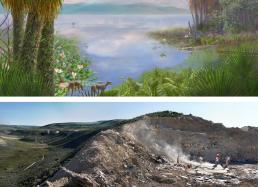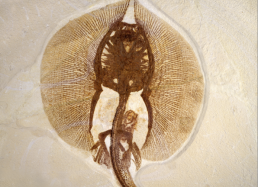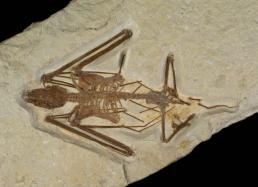Ancient Wyoming
Today, southwestern Wyoming is high mountain desert country, where water is scarce and winters are long and cold. But fossils from the Green River Formation tell us that 52 million years ago, Wyoming’s climate was much warmer and wetter, with a subtropical environment similar to that of the Gulf Coast.
Flanked by volcanoes to the north and surrounded by pine-covered mountains, Fossil Lake formed part of a huge freshwater ecosystem that hosted a diverse plant and animal community, including palm trees, balloon vines, crocodiles, alligators, monitor lizards, boa constrictors, parrots, and many other tropical and temperate species.
The Aquatic Community
Slices of sedimentary rocks reveal much about the distribution of Fossil Lake's different habitats and inhabitants. For example, sedimentary rocks taken from the center of the lake appear to contain few bottom-dwelling species. The lack of stingrays, crayfishes, shrimps, snails, and mollusks here indicates that the deepest waters were probably lethally stagnant.
Instead, such bottom-dwellers appear mostly in near-shore deposits, along with ancient relatives of herrings, perches, and other fishes that live higher in the water column, where oxygen is more readily available. These near-shore habitats also appear to have acted as the main nurseries and breeding grounds for fish: their fossils trace the life stages of many species, revealing them in mating positions, as embryos, and as newborns.
A Snapshot of Survival
From fossils, we can also learn much about interactions between species both in the lake and on land. For example, we can witness the food chain in action through preserved stomach contents and fecal matter (coprolites), as well as animals fossilized in the moment of being swallowed by predators. We can even spot chew marks on leaves and identify the insects likely responsible for the damage.
Many non-aquatic animals and plants are also present, having fallen or washed into the lake from the air or the shore. In fact, one of the world’s oldest flying mammals can be found in the Green River Formation, which is one of the best sources of well-preserved fossil bats and birds in the world!




